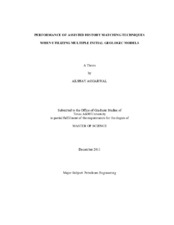| dc.description.abstract | History matching is a process wherein changes are made to an initial geologic model of a reservoir, so that the predicted reservoir performance matches with the known production history. Changes are made to the model parameters which include rock and fluid parameters (viscosity, compressibility, relative permeability, etc.) or properties within the geologic model. Assisted History Matching (AHM) provides an algorithmic framework to minimize the mismatch in simulation, and aids in accelerating this process. The changes made by AHM techniques, however, cannot ensure a geologically consistent reservoir model. In fact, the performance of these techniques depends on the initial starting model. In order to understand the impact of the initial model, this project explored the performance of the AHM approach using a specific field case, but working with multiple distinct geologic scenarios.
This project involved an integrated seismic to simulation study, wherein I interpreted the seismic data, assembled the geological information, and performed petrophysical log evaluation along with well test data calibration. The ensemble of static models obtained was carried through the AHM methodology. I used sensitivity analysis to determine the most important dynamic parameters that affect the history match. These parameters govern the large scale changes in the reservoir description and are optimized using the Evolutionary Strategy Algorithm. Finally, the streamline based techniques were used for local modifications to match the water cut well by well.
The following general conclusions were drawn from this study-
a) The use of multiple simple geologic models is extremely useful in screening possible geologic scenarios and especially for discarding unreasonable alternative models. This was especially true for the large scale architecture of the reservoir.
b) The AHM methodology was very effective in exploring a large number of parameters, running the simulation cases, and generating the calibrated reservoir models. The calibration step consistently worked better if the models had more spatial detail, instead of the simple models used for screening.
c) The AHM methodology implemented a sequence of pressure and water cut history matching. An examination of specific models indicated that a better geologic description minimized the conflict between these two match criteria. | en |


